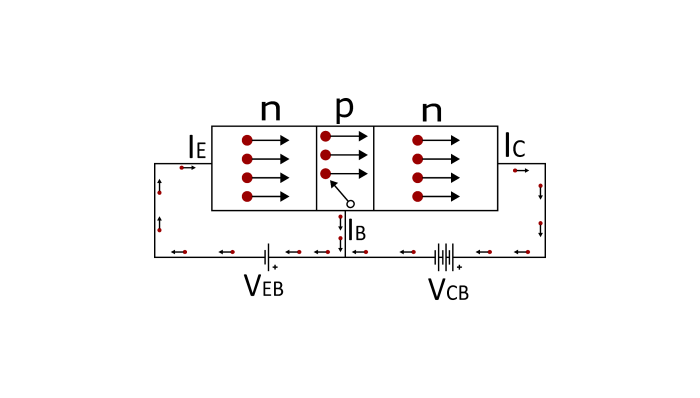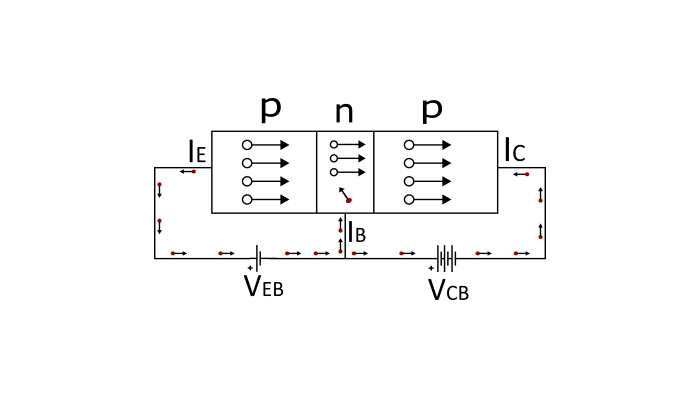
 Data Structure
Data Structure Networking
Networking RDBMS
RDBMS Operating System
Operating System Java
Java MS Excel
MS Excel iOS
iOS HTML
HTML CSS
CSS Android
Android Python
Python C Programming
C Programming C++
C++ C#
C# MongoDB
MongoDB MySQL
MySQL Javascript
Javascript PHP
PHP
- Selected Reading
- UPSC IAS Exams Notes
- Developer's Best Practices
- Questions and Answers
- Effective Resume Writing
- HR Interview Questions
- Computer Glossary
- Who is Who
Bipolar Junction Transistor (BJT) - Theory
A Bipolar Junction Transistor (BJT) is a three-terminal device which consists of two pn-junctions formed by sandwiching either p-type or n-type semiconductor material between a pair of opposite type semiconductors.
The primary function of BJT is to increase the strength of a weak signal, i.e., it acts as an amplifier. A BJT can also be used as a solid state switch in electronic circuits.
Types of BJT
There are two types of BJTs −
- NPN Transistor
- PNP Transistor
In this article, we will discuss in detail the working principle of both these types of BJTs.
NPN Transistor
An npn-transistor is composed of two n-type semiconductor materials which are separated by a thin layer of p-type semiconductor. The two terminals viz. Emitter and Collector are taken out from the two n-type semiconductor and the Base terminal is from the p-type semiconductor.
In BJT symbol, the arrow on the emitter terminal indicates the direction of conventional current in the emitter with forward bias. For npn-transistor, the conventional current flows out of the emitter as indicated by the outing arrow.

PNP Transistor
A pnp-transistor is composed of two p-type semiconductors which are separated by a thin layer of n-type material. The two terminals viz. Emitter and Collector are taken out from the two p-type semiconductor layers and the Base terminal is from the n-type semiconductor. For the pnp-transistor, the conventional current flows into the emitter as indicated by the inward arrow.

Important Facts about BJT
There are two pn-junctions, hence a transistor may be regarded as a combination of two back-to-back connected diodes.
The collector region is wider than both emitter and base. The base is much thinner than both emitter and collector. During the transistor operation, a lots of heat is generated at the collector, hence the collector is made larger to dissipate the heat.
A transistor has three sections of doped semiconductors. The one section is called the Emitter, the other is called the Collector, and the middle section is called the Base and forms two pn-junctions between emitter and collector.
In general, the emitter-base junction of the BJT is made forward-biased, whereas the collector-base junction is reverse-biased.
The resistance of forward-biased junction is very small as compared to that of the reverse-biased junction.
The emitter is heavily doped so that it can supply a greater number of charge carriers (electrons or holes) to the base. The base is lightly doped and very thin, hence it passes most of the charge carriers injected by the emitter to the collector. The doping concentration of the collector region is moderate.
Working Principle of BJT
The emitter-base junction of BJT is forward-biased, whereas the collector-base junction is reverse biased. The forward bias of the emitter-base junction causes the emitter current to flow and this emitter current entirely flows in the collector circuit. Therefore, the collector current depends upon the emitter current and nearly equal to the emitter current.
Working of NPN Transistor
With the forward-biased emitter-base junction and reverse-biased collector-base junction, it can be seen that the forward bias causes the flow of electrons from the n-type emitter into the p-type base. This constitutes the emitter current (). As these electrons flow through the p-type base, they tend to combine with the holes.
Since the base is lightly doped and very thin, hence, only a small number electrons (less than 5%) combine with the holes to constitute the base current (). The remaining (more than 95%) electrons cross over the base region and reach to the collector region to constitute the collector current (). In this manner, the entire emitter current flows in the collector circuit.

The emitter current is the sum of base and collector currents.
$$\mathrm{{I_{E}}={I_{B}}+{I_{C}}}$$
Working of PNP Transistor
For the pnp-transistor, the forward bias of emitter-base junction causes the flow of holes in the p-type emitter region towards the n-type base and constitutes the emitter current (${I_{E}}$). As these holes cross into the n-type base region, they tend to combine with the electrons. Since the base is lightly doped and very thin, hence only a small number of holes (less than 5%) combine with the electrons. The remaining (more than 95%) cross the base and reach into the collector region to constitute the collector current (${I_{C}}$).
In this manner, the entire emitter current flows into the collector circuit. It may be noted that the current conduction inside the pnp-transistor is due to the movement of holes. However, in the external connecting wires, the current is still due to the flow of electrons.

Again, the emitter current is the sum of collector current and base current.
$$\mathrm{{I_{E}}={I_{B}}+{I_{C}}}$$
BJT Biasing
A BJT has two pn-junctions viz. emitter-base junction and collector-base junction. Application of proper DC voltage at the two junctions of the BJT is known as BJT or Transistor Biasing.

When a transistor used as an amplifier, the emitter-base junction is forward biased and collector-base junction is reverse biased. If the transistor is operated under this bias condition then it is said to be operating in the active region.
When both the junctions are forward biased then the transistor is said to be operating in the saturation region. The transistor operated in saturation region acts like a closed switch and the collector current becomes maximum.
When both the junctions are reverse biased, the transistor is said to be operating in the cut off region. The BJT operated in cut off region acts as an open switch and a very small collector current (in µA) flows from emitter to collector. This current is called reverse leakage current and is due to minority charge carriers (electrons in p-region and holes in n-region).
| Emitter-Base Junction |
Collector-Base Junction |
Operating Region |
|---|---|---|
| Forward Biased |
Reverse Biased |
Active Region |
| Forward Biased |
Forward Biased |
Saturation Region |
| Reverse Biased |
Reverse Biased |
Reverse Biased |

